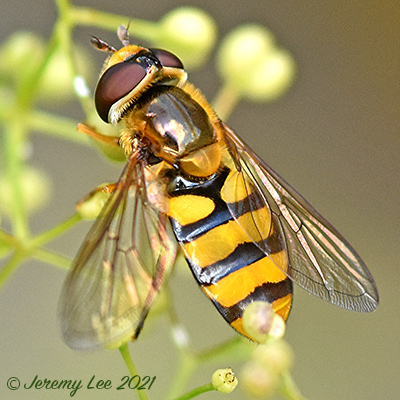
 |
|
Scientific Classifications explained » Amphibians » Ants » Aphids » Bees » Beetles » Birds » Bugs » Butterflies » Caterpillars » Damselflies » Dragonflies » Earwigs » Flies » Frog/Leafhoppers » Fungi » Galls » Grasshoppers » Harvestmen » Hoverflies » Lacewings » Ladybirds » Leaf Mines » Lichens » Mammals » Millipedes » Mosses » Moths » Sawflies » Slugs » Snails » Spiders » Trees & Shrubs » Wasps » Wild Flowers » Woodlice » Postboxes |
UK Nature > Hoverflies > Eupeodes latifasciatus

Scientific Name: Eupeodes latifasciatus Common Name: N/A Eupeodes latifasciatus is a species of varying abundance in the UK, some years being quite common, then almost disappearing the next. Females usually have the markings on the abdomen fused to form moustached bands. These bands run nearly parallel with the front edge of the tergite particularly on tergite 3. The yellow never reaches the lateral edges of the tergites. The frons is equally black and yellow, with no forward extension. Males tend to have spectacle shaped markings and the occiput (grey band on back of eyes) does not taper as significantly as in other species towards the top. Adults feed on nectar, larvae feed on aphids and scale insects. Inhabiting open areas, with a preference for damp meadows and lush vegetation, but can be found in gardens (where the specimen above was found). On the wing March to October, peaking in August. Fairly widespread in the UK, but more frequent in the south. |
|

https://www.uknature.co.uk is a website dedicated to showing the immense diversity of UK nature and wildlife. Our vast range of habitats, from lowland arable to snow covered mountains, from storm-ravaged coastlines to peaceful inland freshwater lakes and rivers, from dry, sandy heaths to deciduous and coniferous forests, all these habitats contribute to the abundance of UK nature. We have wild birds in huge numbers either residing or visiting our shores (597 recorded species as at July 2013) and we must also not forget the humble back garden with its grass lawns, flower beds filled with nectar rich flowers, shrubs and trees, all designed to attract huge numbers of insects such as bees, moths, butterflies and hoverflies; and finally the small ponds which provide safe havens for frogs, toads, newts and even slow worms and grass snakes. www.uknature.co.uk is the showcase for my personal passion, photographing uknature in all its glory. I sincerely hope you all enjoy the fruits of my labours. This site and all images contained therein is © Jeremy Lee 2004 - 2025. All Rights Reserved. Site design by Jeremy Lee. Site development & IT Support by Stuart Lee. |